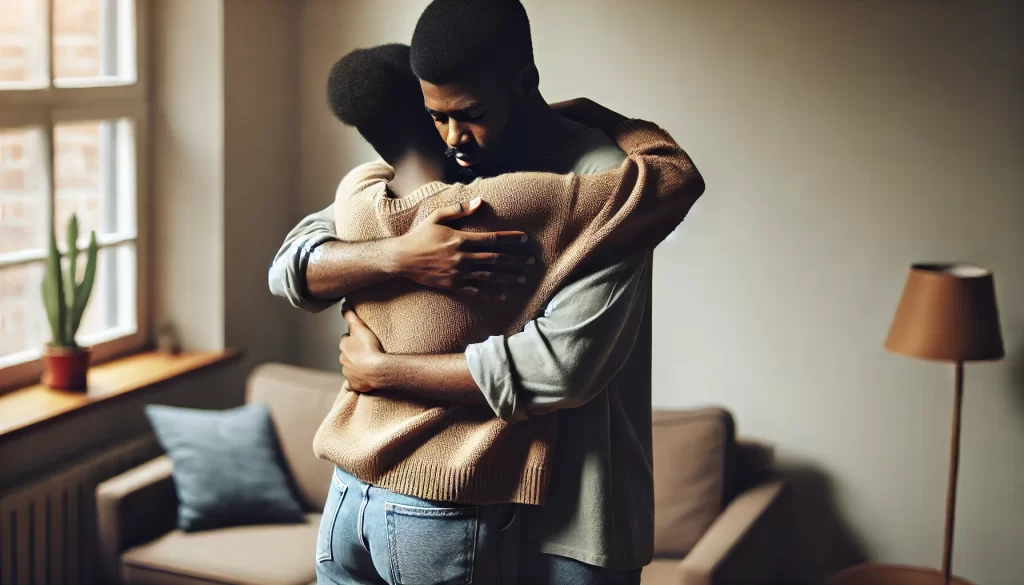Do you ever feel like love isn’t enough? It might be because of what’s called an “emotional blueprint.” This idea could be the key to building a strong, satisfying bond with your partner.
Amber Dalsin, a psychologist and couples therapist, found something interesting. After spending over 10,000 hours with clients, she saw a pattern. This pattern is the emotional blueprint – a set of traits, thoughts, and habits we get from our past family.
Our emotional blueprint acts like our emotional DNA. It shapes how we react to things and people in our lives. Once you and your partner learn about this, you can work together. You can improve your Emotional Blueprint. This can make your relationship way better.
Understanding the Emotional Blueprint
The idea of an emotional blueprint shows we all get certain ways of thinking and acting from our family. This ’emotional DNA’ affects our reactions in life. Often, we don’t even realize it.
Your family patterns and how you get along with others are key in your emotional blueprint. Even if you don’t know much about your family’s past, it impacts you deeply. For instance, someone who sees a lot of broken marriages in their family might face challenges in their own relationships. This is where systemic therapy can help by looking at the bigger family picture.
Your emotional blueprint influences everything, from how you handle money to the success in your career. Realizing the strength of your emotional DNA is a big first step. It helps you understand those hidden forces that direct your life.
| Key Insights | Implications |
|---|---|
| Emotional DNA is passed down through generations | Influences responses to experiences and early life events |
| Invisible patterns related to money, relationships, leadership, success, fear, and health | Can limit individuals in various aspects of life |
| Good emotional DNA can result in positive inherited traits | Shapes values, success patterns, and financial capabilities |
Learning more about your emotional blueprint can open doors to a better life. This systemic way of looking at things brings hope and understanding. It allows you to deal with your emotional DNA and design the life you dream of.
The Impact of Emotional Blueprints
Emotional blueprints deeply affect our lives, often without us realizing it. Psychologist Judy Wilkins-Smith explains how these patterns influence our views and actions. They touch on areas like relationships, family, money, success, and health.
Our emotional DNA comes from the past and affects how we react today. Family and relationship patterns set the stage for how we deal with emotions and grow. This can lead to what’s known as generational trauma and affect our emotional intelligence.
Imagine growing up in a home where money was always tight. This might cause a fear of not having enough. In turn, it could lead to behaviors that stop you from reaching financial security. Or think about growing up in a place where relationships were unhealthy. This could make it hard to build good connections as you grow up.
The great thing is, once we understand how these blueprints work, we can change them. By looking at ourselves and getting help from therapy, we can make positive changes. And with self-trust and self-love, we have the power to build the lives and relationships we dream of.
Creating an Emotional Blueprint for Your Relationship
Creating an emotional blueprint for your relationship involves designing a strategic plan that considers the emotional needs, expectations, and goals of both partners. It’s akin to architectural blueprints used in building a house, where each detail of the structure is planned out to ensure stability and functionality. In the context of a relationship, this blueprint helps partners understand and manage their emotional landscape, facilitating better communication, empathy, and intimacy. By explicitly mapping out how they will handle conflicts, express love, and support each other, couples can create a strong foundation that nurtures their relationship.
Christian counseling often emphasizes the importance of foundational values such as forgiveness, patience, and selflessness in relationships. According to Dr. Gary Chapman, author of “The 5 Love Languages,” understanding and implementing these values are crucial in crafting a relationship blueprint. He suggests that knowing your partner’s primary love language—whether it’s words of affirmation, acts of service, receiving gifts, quality time, or physical touch—can significantly enhance emotional connectivity. Chapman advocates for the use of these love languages as tools to effectively meet each other’s emotional needs, thereby strengthening the relational bond.
Furthermore, Christian counselors like Dr. Tim Clinton, in his book “Competent Christian Counseling” highlight the role of spiritual commitments in supporting emotional health in relationships. He argues that a relationship grounded in shared spiritual values can provide a deeper sense of purpose and guidance. Clinton stresses the importance of prayer, mutual respect, and shared religious practices in creating a resilient emotional blueprint. These elements not only foster a positive emotional environment but also help couples navigate through the challenges of life together, using their faith as both a buffer and a guide.

The Benefits of an Emotional Blueprint
Creating an emotional blueprint with your partner can greatly help your relationship and your Christian marriage. It allows you to understand each other’s emotional needs better. This leads to more happiness, improved intimacy, and a stronger emotional bond.
By looking into your emotional past, you and your partner can learn about yourselves. This knowledge makes communication stronger. You’ll be better at handling arguments and making your Christian marriage happier with Christian counseling for marriage.
Developing an emotional blueprint also boosts empathy and kindness. As you both share your feelings and experiences, you grow to understand each other more. This understanding makes you both better at helping and supporting one another in hard times. It brings you closer emotionally.
In the end, this emotional blueprint benefits your whole relationship. It makes your bond stronger and your intimacy skills better. With this deep connection, you and your partner can create a lasting, strong, and happy Christian marriage.
Conclusion
The idea of an “emotional blueprint” is very important for couples looking to deepen their relationship. By learning about their emotional patterns from the past, partners can choose to form the emotional bonds they really want. This tool is great whether you’re looking for advice, wanting to strengthen your bond, or thinking about Christian marriage counseling.
Developing emotional intelligence helps a lot. This includes being aware of yourself, controlling your emotions, staying motivated, being empathetic, and having strong social skills. You and your partner can change quick reactions into thoughtful actions. This makes you better at talking and builds trust. It’s key for facing tough times together.
The road to creating a relationship’s emotional blueprint is about getting to know yourself better, being open, and wanting to grow. It’s important to realize that deep connections come from dealing with our emotional pasts together. This effort leads to a relationship that’s deeply satisfying, strong, and true to what you both want.

